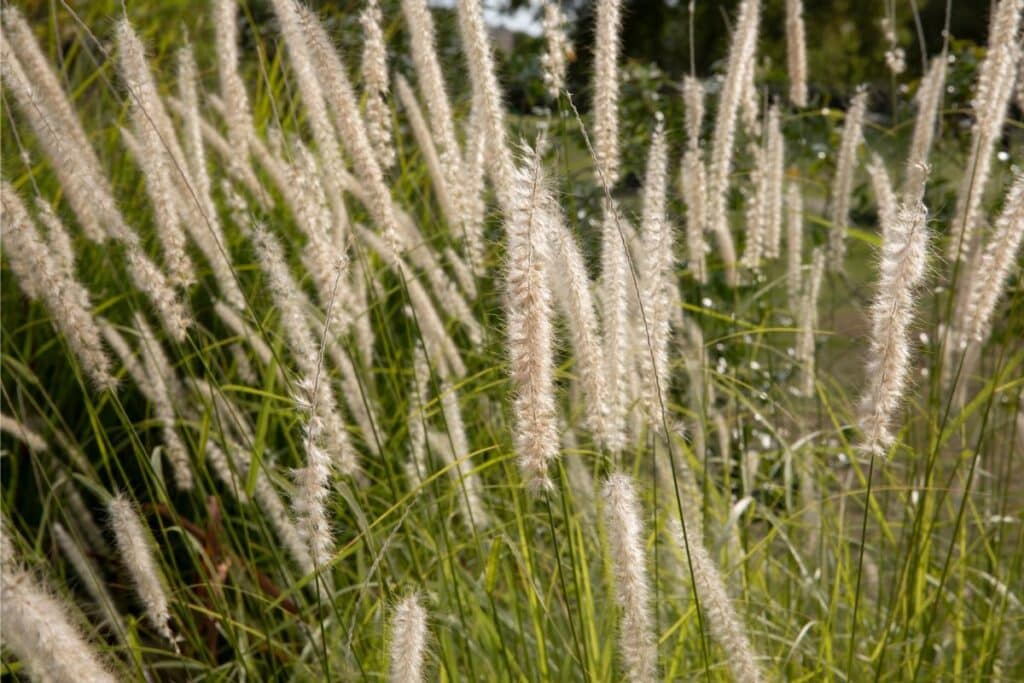Fountain grass (Pennisetum) is a perfect ornamental grass to include in your garden if you need something showy yet hardy. These beautiful grasses will add lots of soft texture with their wispy plumes and they are great statement plants for gardens because their tall leaves create a showy fountain effect.
These perennials are pretty easy to grow and are ideal for mass planting because they can self-sow or spread through their rhizomes. They are ideal for creating focal points in gardens and are practical for dry or rocky garden spaces.
Fountain grass is listed as an invasive plant species in the United States Invasive Plant Atlas because it contributes to the decline of native grasses.
In this guide, we are going to share some helpful tips on the best way to care for and grow this beautiful grass if you want to create showy and interesting landscapes.
Plant Facts
| Scientific name | Pennisetum |
| Common names | Fountain Grass, African Fountain Grass, Fountaingrass, Red Fountain Grass, Purple Fountain Grass, Elephant Grass |
| Family | Poaceae |
| Plant Type | Ornamental Grass |
| Height and Width | 2 – 4.5 Feet tall and 23 – 35 inches wide |
| Origin | Africa, Asia, Australia, and Latin America with some in Europe and North America |
| Flower colors | White, pink, copper, or purple hues |
| Foliage color | Bright green, golden yellow, or beige |
| Sun Exposure | Full sun to partial shade |
| Soil Type & pH | Well-drained sand, chalk, or loam soil and alkaline to acidic soil types |
| Special features | Low maintenance, good for containers, rock gardens, borders, and filler plants. |
What Does Fountain Grass Look Like?
Fountain grass can add lots of charm to your garden spaces because it forms striking feathery plumes or bristly seed heads on tall spikes and the leaf blades have a fine texture that has a softening effect on gardens.
In early spring, the dormant rhizomes will start to sprout vibrant green leaves. The foliage is tall and slender and can give your garden a wavy effect.
Charming blooms will start appearing in late summer and fall and will add lots of interest to your garden because they can be showy with colors like white, pink, copper, or purple, depending on the variety.
The deciduous grasses will start to die back after the first frost. The foliage will transform into golden yellow tones but it will still add lots of winter interest since these dense clumps will stay upright for a long time.
The dead foliage can be cut back in late winter or early spring so new growth will be boosted.
Where Does Fountain Grass Grow?
Fountain grass can be found in many warm and tropical regions like northern Africa, western Asia, Latin America, and even Australia.
These warm-season grasses prefer warmer climates but many varieties are cold-hardy and can survive in hardiness zones 4 – 10.
You can spot these grasses in meadows, and open woods and they flourish alongside streams or roadsides.
The clump-forming grasses can be grown inside gardens and can also be used in container gardening because they take well to garden pots.
How to Grow Fountain Grass
Fountain grass can spread through rhizomes or seeds and they do tend to self-sow. The ornamental grass will flourish if you grow them under the right conditions. Here is a quick look at the growing requirements for this popular plant.
Propagation
The clump-forming grasses will spread by rhizomes which can be divided if you want to mass-plant them. The best time for propagation is late winter or early spring because this will allow the new plants to establish themselves before the intense summer heat arrives.
To propagate fountain grass, you can start by unearthing the root system with the help of a spade or shovel.
Next, you can cut the clumps into smaller sections by using a clean but sharp cutting tool. Try to discard any rotting or dead plant matter.
After dividing the clumps, the grass should be replanted immediately or they can become damaged. The new plants should be watered properly after planting and they should be kept moist until the new shoots take well.
Soil
These graceful grasses will only grow well if it is planted in well-draining soil because the rhizomes will start to rot in bogged or waterlogged conditions.
The grass grows best in fertile loam soil that is slightly acidic to neutral but it can also grow well in chalk or sandy soil that is slightly alkaline as long as there is lots of organic matter present.
Pruning
It is possible to prune back the top of the grasses but this may cause some stress. Most gardeners will wait until the grass is dormant before pruning away dead growth. Because these grasses can look beautiful even in winter, it is best to wait until late fall or early spring before removing the dead foliage.
You can prune the grass by cutting it down to about 2 – 6 inches above ground level.
When to plant fountain grass?
You can plant fountain grass in fall or spring. However, the best time to sow fountain grass seeds depends on your climate and the specific variety you are working with.
Here are some general guidelines:
For Spring Planting:
In regions with mild climates or USDA hardiness zones 8 and above, it is generally recommended to plant fountain grass in spring after the last frost date. This allows the grass to establish a strong root system before the heat of summer arrives.
For Fall Planting:
For cooler climates or USDA hardiness zones 7 and below, fall planting is often preferred. By planting in early to mid-fall, the grass has a chance to establish its roots before winter dormancy. This allows it to be well-prepared for vigorous growth in the following spring.
How to Care for Fountain Grass
These grasses can stay healthy and look striking with hardly any maintenance from your side but they do have a couple of basic needs that should be tended to or they might die out.
Here are some fountain grass care tips you can follow.
Water
Fountain grass can be drought tolerant at times but it should be watered regularly during its growing season. You can water this plant 1 – 2 times per week but should wait until the soil is completely dry between watering.
Sunlight
This grass species rely on sunlight for survival. It flourishes in a full sun position with a minimum of 6 hours of direct sunlight but can also survive in part shade positions. In full shade, the grass will flop over and it won’t produce flower spikes if it receives too much shade.
Temperature and Humidity
These ornamental grasses are quite versatile in terms of temperature. They can grow well in colder zones with temperatures as low as 20 degrees F but are also heat tolerant. Fountain grasses typically grow in tropical regions and grow best at higher temperatures.
Gardeners don’t have to worry about the humidity levels of these grasses. They will flourish in high humidity conditions but can also tolerate dry climates.
Fertilizer
This grass variety is a very light feeder but you can give it a little bit of fertilizer if it is planted in poor soil or if you want to give your grass a boost. Fountain grass will grow well if it is fertilized four times a year. It is best to focus on a slow-release fertilizer so the grass can be nourished over a period of time.
Pests and Diseases
Elephant grass is relatively pest and disease resistant but there are a couple of issues that you can look out for such as the following.
Rust Fungus
Rust fungus is a disease that is caused by pathogenic fungi. This parasite can affect a huge variety of plant species including ornamental grasses and will result in rust spots or markings all over the grass leaves.
Rust fungi are usually transferred to ornamental grass through other infected plants but your grasses can also develop rust disease if it is grown in moist soil with lots of humidity.
To prevent rust, you should try to avoid getting water on the leaf blades and wait for the soil to dry out completely between waterings. Treatments like sulfur dusting or botanical fungicides and pesticides can also combat these problems.
Slugs and Snails
Slugs and garden snails also enjoy feeding on the leaves of most ornamental grasses and can cause quite a bit of devastation. These soft-bodied pests will create a lot of holes in your grass or might even kill the entire plant.
There are lots of different ways to combat slugs and snails including handpicking, setting up slug barriers, setting out bait, companion planting with repelling plants, and others.
Fountain Grass Companions
Fountain grass can look striking all on its own but gardeners often pair it with companion plants that can add more contrast or color to their beds.
The best fountain grass companion plants are other ornamental grass varieties. This is to create interesting texture-rich spaces. Or you can pair it with ornamental plants like verbena, coneflowers, Tuscan sunflowers, sedums, lavender, or alliums because these flowers will bring lots of cheer to your garden and they have similar growing requirements.
Fountain Grass Landscaping Ideas
There are lots of different ways to use fountain grass to create showy or interesting garden spaces.
Here is a quick look at some of the most common ways these grasses are used in landscape design.
Xeriscape or Dry Gardens
Because fountain grass is drought tolerant, it is often used in dry garden spaces or xeriscape projects.
These plants can be paired with other textures and color-rich hardy plant species along with natural materials like rocky boulders, pebbles, and beautiful stumps to create interesting landscapes. Fountain grass will add lots of soft movement to your spaces and is great for creating mesmerizing lawn-free spaces.
Wild or Rock Gardens
If you love a wild and natural garden look then you can also mass-plant showy fountain grass among natural rocks, pebbles, and boulders. Combine different grass species and florals to create spaces that can support local bird, bee, and butterfly populations.
Common Varieties and Cultivars of Fountain Grass
There are just about 80 different species or cultivars of fountain grass and the different varieties can vary in terms of flower color, foliage color, and height. Here is a quick look at some of the most common cultivars or varieties.
- ‘Rubrum’ or purple fountain grass
- ‘Hameln’
- ‘Cassian’
- ‘Fox Trot’
- ‘Little Bunny’
- ‘Little Honey’
- ‘Moudry’
- ‘National Arboretum’
Conclusion
Fountain grass is a terrific selection for your garden if you want to create low-maintenance spaces that are full of movement and texture. These versatile grasses take well to various growing spaces and they have many different garden applications.
We hope that the advice and tips offered in this planting guide are helpful for growing healthy and strong fountain grass clumps so you can have a beautiful garden that offers lots of interest throughout the year.
References
Reference List
CAL-IPC – Pennisetum Setaceum Species Profile – https://www.cal-ipc.org/plants/profile/pennisetum-setaceum-profile/
Edward F. Gilman – Pennisetum Setaceum ‘Rubrum’ Purple Fountain Grass – https://edis.ifas.ufl.edu/publication/FP464
Susan Mahr, University of Wisconsin – Fountain Grass, Pennisetum alopecuroides – https://hort.extension.wisc.edu/articles/fountain-grass-pennisetum-alopecuroides/
USDA – Field Guide for Managing Fountain Grass in Southwest – https://www.fs.usda.gov/Internet/FSE_DOCUMENTS/stelprdb5410113.pdf
The University of Minnesota Extension – Slugs in home gardens – https://extension.umn.edu/yard-and-garden-insects/slugs
Close
*image by gdemiceu/depositphotos







